Networking cables
Networking Cables
UTP cables
UTP Cables or Unshielded Twisted Pair cabling and also known as cat 5 cable is a type of wiring in which two conductors (the forward and return conductors of a single circuit) are twisted together for the purposes of canceling out electromagnetic interference (EMI) from external sources; for instance, electromagnetic radiation from Unshielded Twisted Pair (UTP) cables, and crosstalk between neighboring pairs and it’s terminated with an RJ45 connectors. UTP cable can reach a distance of 100m (328 ft) In addition, to UTP there are some other kind of cables that can be used like the UTP. First one is S/UTP Screened unshielded twisted pair also known as Fully Shielded (or Foiled) Twisted Pair (FTP), is a screened UTP cable.
Second, is the STP Shielded twisted pair: it includes metal shielding over each individual pair of copper wires. This type of shielding protects cable from external EMI (electromagnetic interferences). STP cables can reach up to 25m (82 ft).
Third is the S/STP cabling, also known as Screened Fully shielded Twisted Pair (S/FTP), is both individually shielded (like STP cabling) and also has an outer metal shielding covering the entire group of shielded copper pairs (like S/UTP). This type of cabling offers the best protection from interference from external sources, and also eliminates alien crosstalk. The main deference between these kinds of cables are the twisting and the shielding. Therefore, the more shielding and twisting on the cables, the less chances loosing the massages; however, the cost will increase.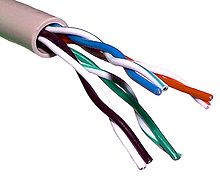
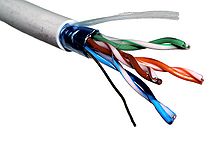
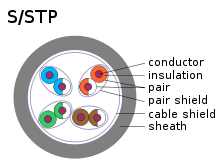
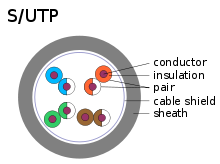
Coaxial cables
Coaxial cable consists of a copper conductor surrounded by a layer of flexible insulation. Over this insulating material is a woven copper braid, or metallic foil, that acts as the second wire in the circuit and as a shield for the inner conductor. This second layer, or shield, also reduces the amount of outside electromagnetic interference. Covering the shield is the cable jacket. Some coaxial cables can run up to 185m others with the thicker net run up to 500m. Even though, they run for a shorter distance, but there cost is much less then the optical fiber cables.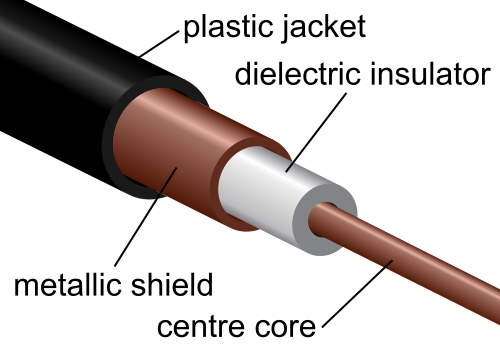
Optical Fiber
Optical Fiber Cables can be classified into single or multi mode fiber. First, single mode has a small core that carries a single ray usually of laser. Single mode fiber can run up to 100 km, (62,14 mi.).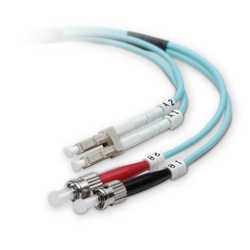 Multi mode fiber has a large core that carries many coherent rays that are usually LED lights. Multi mode can run up to 2km, (6560 ft).
Single mode fiber can run for longer distance than multi mode one of the reasons is that in single mode fiber the laser travels straight through the center of the cable. While, in the multi mode the LED light enters the multimode fiber at different angles. Because light entering the fiber at different angles takes different amounts of time to travel down the fiber, long fiber runs may result in the pulses becoming blurred on reception at the receiving end.
Optical fibers cables use a variety of connectors. The most common ones are
Straight-Tip (ST) (trademarked by AT&T) - a very common bayonet style connector widely used with multimode fiber.
Multi mode fiber has a large core that carries many coherent rays that are usually LED lights. Multi mode can run up to 2km, (6560 ft).
Single mode fiber can run for longer distance than multi mode one of the reasons is that in single mode fiber the laser travels straight through the center of the cable. While, in the multi mode the LED light enters the multimode fiber at different angles. Because light entering the fiber at different angles takes different amounts of time to travel down the fiber, long fiber runs may result in the pulses becoming blurred on reception at the receiving end.
Optical fibers cables use a variety of connectors. The most common ones are
Straight-Tip (ST) (trademarked by AT&T) - a very common bayonet style connector widely used with multimode fiber.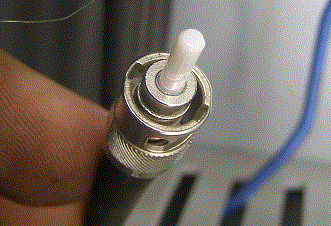
Subscriber Connector (SC) - a connector that uses a push-pull mechanism to ensure positive insertion. This connector type is widely used with single-mode fiber.
Lucent Connector (LC) - A small connector becoming popular for use with single-mode fiber and also supports multi-mode fiber. Optical fiber cables are great for long distance and not susceptible to IEM and other interferences and less electrical hazards; however, these cables and installing it cost more than regular copper cables.
Cables with RJ45 connectors
There are other kinds of cables that have RJ45 connectors on each end.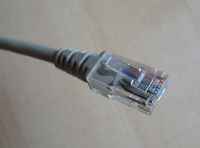 First is the straight through UTP cable: A straight-through cable has connectors on each end that are terminated the same according to the T568A or T568B standards. This kind of cable used to connect different categories for example
Computer to printer
Switch to a router Ethernet port
Switch to a computer
Crossover cables
Crossover cables are terminated with T568A termination at one end and T568Bat the other end.
First is the straight through UTP cable: A straight-through cable has connectors on each end that are terminated the same according to the T568A or T568B standards. This kind of cable used to connect different categories for example
Computer to printer
Switch to a router Ethernet port
Switch to a computer
Crossover cables
Crossover cables are terminated with T568A termination at one end and T568Bat the other end.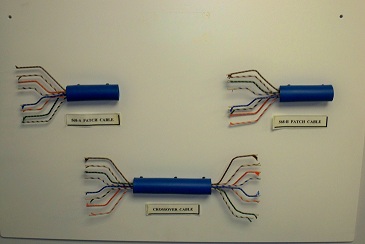 The kind cables are used to connect similar devices or similar categories for example
Computer to computer
Router Ethernet port to computer
Switch to switch
The kind cables are used to connect similar devices or similar categories for example
Computer to computer
Router Ethernet port to computer
Switch to switch
Finally is the Rollover Cables
Rollover cable is a Cisco property, and is used to connect a consul with a port to a computer. For example
Switch< Rollover cable with RJ45 on both ends> > DB-9Serial port > >computer
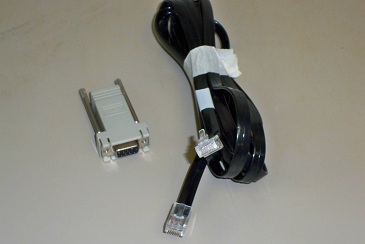
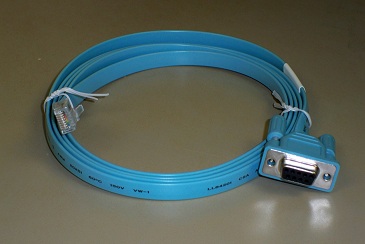
V.35
V.35 is a Cisco high-speed serial interface designed to support both higher data rates and connectivity between DTEs (data-terminal equipment) or DCEs (data-communication equipment) over digital lines. Although V.35 is commonly used to support speeds ranging anywhere from 48 to 64 Kbps, much higher rates are possible ISDN (64 or 128Kbps), Factional T1@ 128 Kbps to 1.544Mbps T1, ATM and Frame Relay]. V.35 cable distances theoretically can range up to 4000 feet (1200 m) at speeds up to 100 Kbps. Actual distances will depend on your equipment and the quality of the cable. LAN routers often come equipped with a V.35 electrical interface but many today are using a HSSI interface at speeds higher than T1 and above (typical T3 45Mbps).